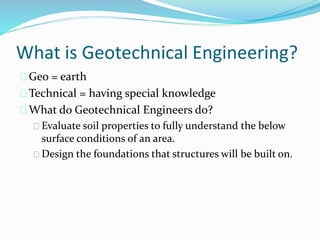7 Easy Facts About Geotheta Described
7 Easy Facts About Geotheta Described
Blog Article
The Ultimate Guide To Geotheta
Table of ContentsThe 2-Minute Rule for GeothetaTop Guidelines Of GeothetaThe Basic Principles Of Geotheta Geotheta Fundamentals ExplainedThe Only Guide for Geotheta

They conduct site investigations, accumulate examples, execute research laboratory tests, and evaluate data to examine the viability of the ground for building and construction tasks - Engineer of Record. Based upon their searchings for, geotechnical designers supply suggestions for structure style, incline stability, keeping frameworks, and reduction of geotechnical threats. They team up with various other experts, such as architects, structural designers, and building groups, to make certain that geotechnical factors to consider are integrated into the general task design and application
By assessing the behavior and homes of soil and rock, they can recognize potential geotechnical dangers such as landslides, soil negotiation, or incline instability. Their knowledge aids prevent failings or mishaps that could threaten lives and building. Below are some comprehensive responsibilities and obligations of a geotechnical designer: Website Examination: Geotechnical designers conduct website investigations to collect information on subsurface problems.
They translate the data to understand the residential properties and actions of the dirt and rock, including their strength, leaks in the structure, compaction features, and groundwater problems. Geotechnical Evaluation and Layout: Geotechnical designers evaluate the data collected throughout website investigations to assess the security and viability of the site for building and construction jobs. They perform geotechnical calculations and modeling to review variables such as bearing ability, settlement, slope security, lateral earth stress, and groundwater flow.
Excitement About Geotheta
Foundation Layout: Geotechnical designers play a critical duty in designing structures that can safely sustain the desired framework. They assess the dirt conditions and tons demands to identify the suitable foundation kind, such as shallow structures (e.g., grounds), deep structures (e.g (https://www.behance.net/ianhammond2)., piles), or specialized strategies like soil enhancement. They consider variables such as negotiation limitations, bearing capacity, and soil-structure interaction to establish optimal structure styles
They review building and construction strategies, screen site activities, and carry out field inspections to verify that the style referrals are complied with. If unforeseen geotechnical concerns occur, they examine the scenario and offer referrals for remediation or adjustments to the layout. Danger Assessment and Mitigation: Geotechnical designers evaluate geotechnical dangers and risks related to the job site, such as landslides, liquefaction, or dirt erosion.

Collaboration and Communication: Geotechnical designers work closely with various other specialists entailed in a job, such as engineers, structural engineers, and building and construction groups. Effective communication and collaboration are necessary to integrate geotechnical factors to consider right into the total job design and building and construction process. Geotechnical engineers offer technical proficiency, response queries, and guarantee that geotechnical needs are fulfilled.
The Definitive Guide to Geotheta
Below are some sorts of geotechnical engineers: Structure Engineer: Foundation engineers focus on creating and assessing structures for structures. They evaluate the dirt problems, load requirements, and website features to figure out one of the most appropriate foundation kind and design, such as shallow foundations, deep structures, or specialized techniques like pile foundations.
They evaluate the variables influencing incline stability, such as soil residential properties, groundwater conditions, and slope geometry, and create methods to avoid slope failings and alleviate threats. Earthquake Engineer: Quake engineers specialize in evaluating and creating frameworks to endure seismic pressures. They evaluate the seismic risk of a website, examine soil liquefaction capacity, and develop seismic layout criteria to guarantee the safety and strength of frameworks during quakes.
They perform area screening, collect examples, and evaluate the collected my link information to characterize the soil residential properties, geologic formations, and groundwater problems at a website. Geotechnical Instrumentation Engineer: Geotechnical instrumentation engineers concentrate on surveillance and determining the behavior of dirt, rock, and structures. They mount and preserve instrumentation systems that keep an eye on factors such as dirt settlement, groundwater degrees, incline activities, and structural variations to evaluate performance and offer very early cautions of prospective problems.
Facts About Geotheta Uncovered
They conduct examinations such as triaxial tests, loan consolidation tests, direct shear examinations, and leaks in the structure tests to gather information for geotechnical analysis and design. Geosynthetics Engineer: Geosynthetics designers concentrate on the style and application of geosynthetic products, such as geotextiles, geogrids, and geomembranes. They make use of these materials to enhance soil stability, strengthen inclines, provide drain remedies, and control disintegration.
They often tend to be investigatory people, which suggests they're intellectual, introspective, and investigative. They are interested, systematic, sensible, logical, and logical. Some of them are additionally social, indicating they're kind, charitable, participating, individual, caring, helpful, empathetic, tactful, and friendly. Does this seem like you? Take our totally free career examination to learn if geotechnical engineer is just one of your top profession matches.
In the workplace setting, geotechnical designers utilize specialized software program tools to carry out calculations, create designs, and examine data. They prepare records, evaluation task specifications, communicate with clients and team participants, and coordinate task tasks. The office setup provides a helpful setting for research, evaluation, and cooperation with other experts entailed in the project.
The Definitive Guide to Geotheta
They regularly visit project sites to conduct website investigations, evaluate geotechnical problems, and gather data for evaluation. These brows through entail taking a trip to various areas, occasionally in remote or tough surfaces. Geotechnical designers may execute soil tasting, conduct tests, and screen building and construction tasks to guarantee that the geotechnical elements of the task are being executed correctly.
Geotechnical designers also work in specialized geotechnical laboratories. Geotechnical laboratory designers work thoroughly in these settings, dealing with testing devices, running tools, and recording information.
Report this page